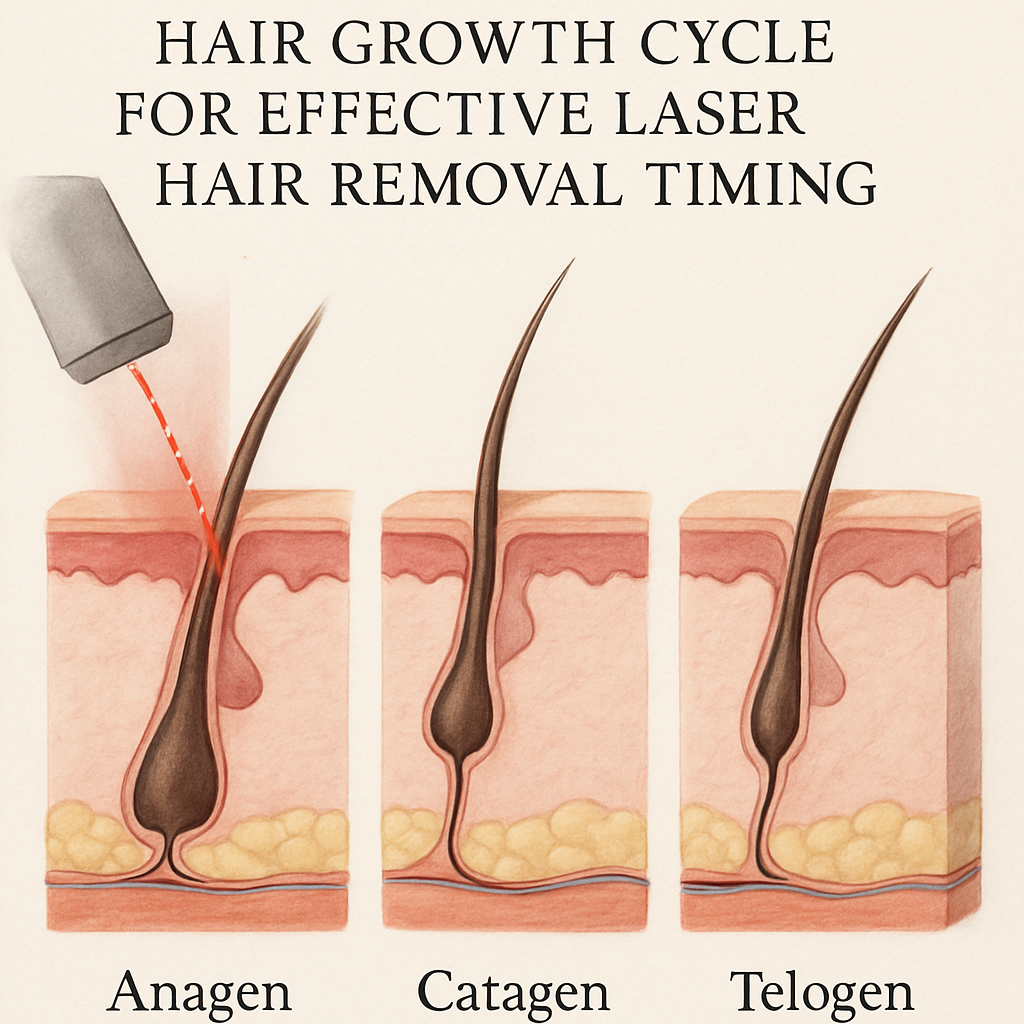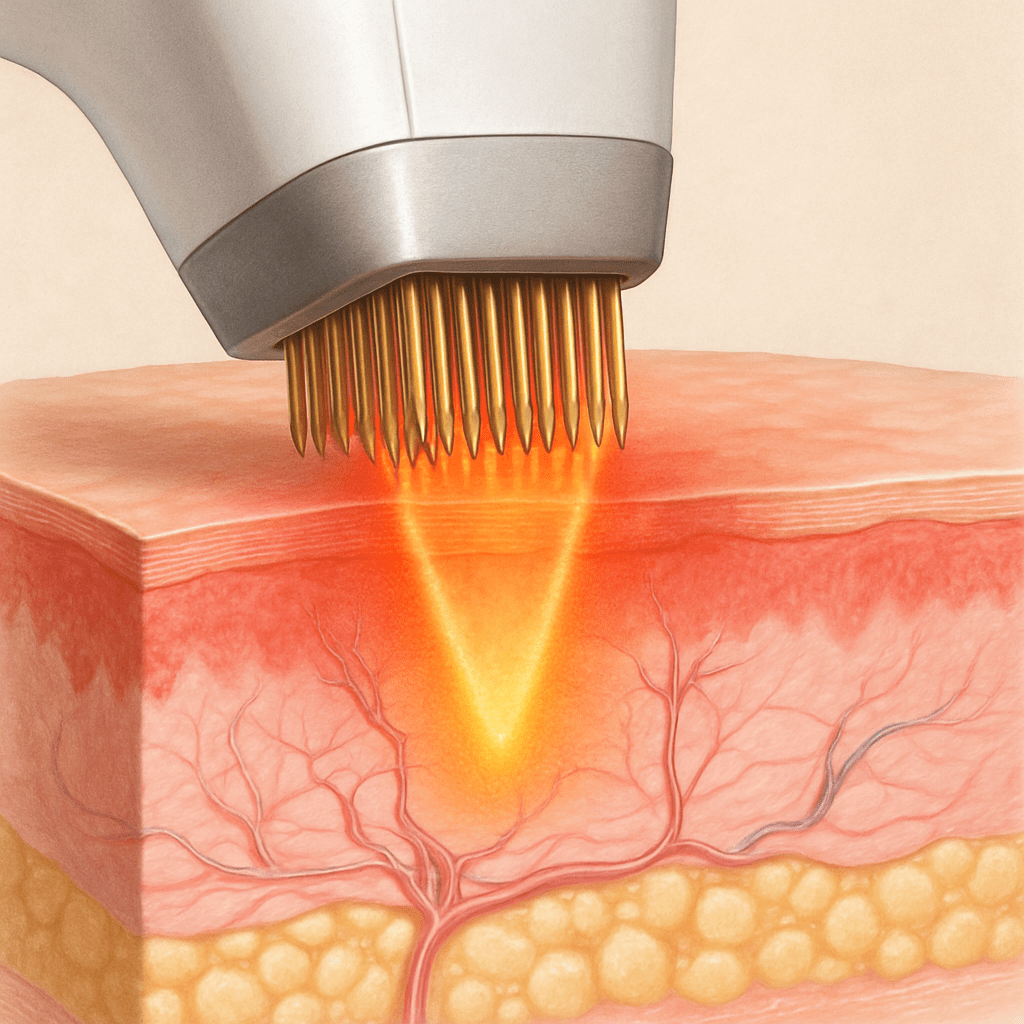You ever wonder why laser hair removal isn’t a one-and-done deal? Like, you go in for a session and expect smooth skin forever, but then months later, there’s that patchy regrowth popping up. It’s frustrating, right? So, how long between laser hair removal sessions do you actually need to wait for the best results? That’s the million-dollar question and the heart of this whole treatment journey.
Here’s the thing: hair grows in cycles, and laser treatments target the hair follicle during its active growth phase. But not all hairs are synced up. Some are asleep, some are waking up, and some are throwing a party somewhere in between. Because of this, you can’t zap them all at once. This means timing your sessions right isn’t just about convenience—it’s key to making sure each treatment hits the right spot at the right time.
Usually, you’re looking at waiting anywhere from 4 to 8 weeks between sessions. Why the variance? Well, it depends on the area you’re treating, your skin type, and even your unique hair growth cycle. For example, facial hair often grows faster than leg hair, so the session frequency can shift accordingly. It’s kind of like watering a plant; you can’t just flood it one day and forget the rest. You need the right care at the right intervals.
Still curious about the best timing for your specific needs? The folks at Simcoe Cosmetic Clinic can help map out a schedule that fits your skin, lifestyle, and goals perfectly. If you want to get a head start on understanding laser hair removal in Barrie, jump over to our detailed guide on what you need to know about laser hair removal. It’s packed with insights that’ll make the whole plan click.
Oh, and if you’re thinking about prepping for your appointments, there’s a nifty side tip: some tech tools can help manage hair care routines, even stuff like heatless curling techniques for your styling days. It seems random but can be a fun way to keep your hair game strong between laser visits—check out this guide on how to use a heatless curling rod headband for beautiful, damage-free curls for some fresh ideas.
So yeah, waiting between sessions isn’t just an annoying stretch; it’s a smart move to finally get that smooth, hair-free skin you’ve been hoping for. Stick with it, and you’ll thank yourself later. Let’s dive in and explore exactly what those wait times mean and how to make the most of each treatment.
TL;DR
Wondering how long between laser hair removal sessions you should wait? Typically, 4 to 6 weeks is the sweet spot to let your hair cycle reset and get the best results.
Patience pays off here—skip the rush, stick to the timing, and you’ll soon enjoy smoother skin without regrets.
Understanding the Hair Growth Cycle and Its Impact on Laser Treatment Timing
Ever wondered why laser hair removal isn’t just a one-and-done kind of deal? Let’s unravel that mystery together. The key lies deep within your skin, where every strand of hair is actually living its own little life cycle. And getting this cycle right is what makes all the difference when you’re figuring out how long between laser hair removal sessions you should wait.
The Three Stages of Hair Growth: Anagen, Catagen, Telogen
Think of your hair growth process like a well-choreographed dance with three parts. First up, there’s the anagen phase, or the “active growth” phase. This is when hair is happily sprouting and firmly rooted in the follicle. Laser treatments are most effective here because the laser targets the pigment in these actively growing hairs, sending a precise zap that heats and damages the follicle, effectively hitting the pause button on hair growth.
Next, comes the catagen phase, a short transition period where hair growth slows and the follicle prepares to rest. And then there’s the telogen phase, where the hair follicle is basically on vacation. The old hair sheds to make way for new growth, but laser treatment won’t do much during this downtime since the follicle isn’t actively growing hair to target.
So, why does this matter? If the laser only works during anagen, and not all your hairs are in that stage at the same time, it’s clear you won’t catch every single hair in one session. That’s why spacing your sessions wisely is essential.
Timing Is Everything: Why You Need Multiple Sessions
Imagine trying to pick apples from a tree — but only the ripe ones are worth picking. Laser hair removal is kind of like that. Studies show that about 85% of your hairs are in the anagen phase at any given time, which means a single treatment can only target those ripe targets. The rest are either on break or growing slowly, meaning they slip right through the laser’s grasp.
Waiting the right amount of time between sessions lets more hairs enter that active growth phase. This is why most experts recommend waiting between 4 to 6 weeks between laser hair removal sessions for areas like the face or underarms. But it can vary; some spots, like your back, have slower hair growth cycles and might require longer intervals—even up to 12 or 16 weeks.
So, when you’re thinking about how long between laser hair removal sessions you need to wait, remember it’s all about catching the hair at just the right stage. Too soon, and many hairs won’t be ready. Too late, and you risk unnecessary regrowth that drags out the whole process.
Spotlight on Results: What You Can Expect
Laser hair removal isn’t magic; it’s biology in action. After a session, you might feel like hairs are still growing, but often they’re just loosening and falling out naturally. This period can last days to weeks following treatment. Then, patience kicks in as you wait for the next batch of hair to enter anagen, ready for their turn under the laser spotlight.
Over a series of treatments — usually around five or six sessions spaced strategically — you’ll see progressively less hair, thinner regrowth, and longer-lasting smoothness. The rest of the hairs eventually cycle through their phases and get zapped.
There’s good news: new advancements have improved laser technology to better target even challenging hair and skin types, but the timing principles still stand strong. For a deeper dive, check out insights from experts on why multiple sessions are needed.
Nailing Your Schedule: Tips For Your Laser Hair Removal Timing
- Listen to your treatment provider; they tailor session timing based on the area treated and how your hair responds.
- Don’t rush into sessions; allowing the hair growth cycle to progress naturally increases the odds of hitting more hairs in the anagen phase.
- Protect your skin between sessions — sun exposure can complicate treatment and increase side effects.
- Consider your own hair growth speed. Facial hair cycles faster than back or leg hair, so timing changes accordingly.
So, does this mean your laser hair removal routine should feel like a slow dance instead of a sprint? Absolutely. Understanding your hair’s rhythm is the secret sauce to smoother results — and fewer sessions wasted chasing hairs that just weren’t ready.

Recommended Time Intervals Between Laser Hair Removal Sessions
Ever wondered why your laser hair removal sessions aren’t just back-to-back appointments? There’s a real rhythm to it, and it’s not arbitrary — your hair’s growth pattern calls the shots.
So, how long between laser hair removal sessions should you actually wait? Well, the timing depends a lot on which body part you’re treating and how your hair follicles behave.
Understanding the Growth Cycle: Why Timing Matters
Laser hair removal targets hair follicles best when hairs are in their active growth phase, called the anagen phase. But here’s the catch: not all hairs grow at the same time. Some are in resting or shedding phases, so zapping too early or too late means missing the target.
That’s why spacing out your sessions gives hair follicles time to cycle into the anagen phase, making each treatment much more effective. If you rush, you’ll likely have to come back for extra sessions — and nobody’s got time for that.
Timing by Body Area: Hormonal vs. Non-Hormonal Zones
Areas influenced by hormones tend to have more stubborn hair. Think face, underarms, and bikini line. Because hormonal signals encourage constant hair regrowth, these spots often need more treatments and shorter intervals between sessions.
The general rule? For hormonal areas, your sessions should be spaced about every 4 to 6 weeks. This allows your hair to grow enough so the laser can effectively target the roots but not so long that unwanted hair takes over again.
Non-hormonal areas like legs, arms, or the back usually require longer gaps — around 6 to 8 weeks between treatments. Here, hair grows slower or in less complicated cycles, so your skin appreciates the extra healing time.
Thinking of it this way: your skin and hair are kind of like a team that needs to prep before the next big play. Give them that time, and the laser scores more points.
Number of Sessions and Expected Wait Times
| Body Area | Estimated Sessions | Recommended Interval Between Sessions | Notes |
|---|---|---|---|
| Face (Hormonal) | 6–8 sessions | 4–6 weeks | More sessions due to hormonal hair growth cycles; results improve with consistency |
| Bikini & Underarms (Hormonal) | 6–10 sessions | 4–6 weeks | Hormonal fluctuation can affect hair; follow-ups may be needed yearly |
| Legs & Back (Non-Hormonal) | 3–6 sessions | 6–8 weeks | Longer interval gives skin healing time; fewer sessions typically required |
It’s normal to feel like this timeline is a marathon, not a sprint. But honestly, this pacing is your best bet for long-lasting smoothness. Rushing through only means you’re likely chasing hairs that weren’t ready for their close-up.
Still curious about how this works? You might find this insightful breakdown from Avere Beauty helpful — they do a great job explaining the science behind the time gaps.
Another thing: pay attention to your visible regrowth. Your next session should ideally happen within about a week of seeing new hair sprouting. Waiting too long might throw off your progress.
Why Listening to Your Body and Provider Matters
If you’ve done laser before or talked to a pro, you know the schedule isn’t set in stone. Skin type, hair thickness, and even hormonal shifts can shake things up. For instance, those with darker skin might have different timing to avoid irritation, as the laser wavelength needs to be carefully chosen.
And if you’re dealing with hormonal conditions like PCOS, expect that the standard schedule might stretch out a bit. Some people even opt for unlimited packages to cover extra sessions that occasionally pop up.
Don’t forget the healing part either — your skin needs some TLC between sessions. Keeping out of the sun, avoiding waxing or plucking, and sticking to shaving helps the laser do its job efficiently.
European Wax Center has a great piece on why this timing matters and how to tailor it based on your unique traits. It’s worth the read if you want to get a full handle on what to expect during your laser journey.
Quick Tips to Nail Your Laser Hair Removal Schedule
- Mark your calendar to book your next session within 4-6 weeks for hormonal areas, 6-8 weeks for others.
- Don’t skip or rush sessions — patience here really pays off.
- Notice visible hair regrowth and time your appointment around that to catch hairs in the right phase.
- Follow your provider’s advice; they see your progress and adjust your plan accordingly.
Keep in mind, laser hair removal is an investment — and like any good investment, it takes time. But once you get the timing right, you’re well on your way to ditching razors and waxing strips for good.
Ready to get serious about your sessions? Chatting with your local laser expert at Simcoe Cosmetic Clinic will set you on the right path with a schedule tailored just for you.
Factors That Affect the Time Between Sessions: Skin Type, Hair Color, and Treatment Area
Ever wonder why your friend’s laser hair removal schedule looks totally different from yours? It’s not just random—there’s a bunch of reasons why the time between your sessions might need to be tweaked, and usually, skin type, hair color, and the specific area getting treated play a bigger role than you might think.
Skin Type: More Than Just a Number
Think about it this way: your skin is like a canvas, but some canvases are trickier to paint on. Darker skin tones contain more melanin, which can absorb more of the laser’s energy. That’s why your laser expert might recommend waiting a bit longer between sessions if you have deeper skin tones. It gives your skin time to recover and lowers the risk of side effects like burns or discoloration.
On the flip side, lighter skin can typically handle slightly shorter gaps between sessions. But even then, it’s not a free-for-all. You still need to follow your provider’s guidance to prevent irritation. If you’re curious, experts like those at the American Academy of Dermatology explain why adjusting timing based on skin type is a best practice to keep you safe and comfortable. Learn more about skin considerations here.
Hair Color and Thickness: The Laser’s Target
Laser hair removal works by zapping the pigment in your hair follicles. Dark, coarse hair absorbs laser light much better than lighter, finer hair. So, if you’ve got dark hair and light skin, you’re in that sweet spot where sessions can be relatively close together—usually every 4 to 6 weeks.
But what if you have blond, red, or gray hair? Laser treatments can still work; they just might need to be spaced out more or require different laser technology to make it effective. The timing stretches out because these hairs don’t react as strongly to the laser, and your hair grows back in different cycles.
Don’t let this discourage you though. There’s been huge progress in lasers designed for varying hair colors and types, so talk with your clinician at Simcoe Cosmetic Clinic about what options fit your unique hair profile.
Treatment Area: Size and Sensitivity Matter
Here’s where things get even more personal. The area being treated affects how frequently you can safely book sessions. Smaller, less sensitive areas like the upper lip or underarms can handle sessions every 4 to 6 weeks because the skin recovers quickly.
But if you’re treating a large or sensitive area, like your back or bikini line, you might need to wait a little longer between sessions. These spots tend to have thicker hair and more delicate skin, so it takes extra care to avoid irritation.
Plus, some areas have different hair growth cycles. Your legs, for example, might follow a slower rhythm naturally, which means waiting a bit longer between treatments makes sense. When you get right down to it, body parts aren’t equal in how they respond—so your schedule shouldn’t be either.
So, How Do You Nail the Perfect Timing?
You see, there’s no one-size-fits-all answer to how long between laser hair removal sessions you should wait. But knowing that your skin tone, hair color, and treatment area all script different parts of the play helps you understand why your appointments aren’t cookie-cutter.
What you can do is keep a close eye on how your skin reacts and talk openly with your laser provider. They’ll assess how your skin is healing and how much hair is regrowing to customize the schedule just for you.
And if you want to dig deeper into what affects your ideal timing and safety during the process, the American Academy of Dermatology offers a solid breakdown of laser hair removal basics and tips on what to expect before and after treatments. Check out their guidance for more insights.
Remember: patience and personalization are your best pals here. With the right schedule tuned to your skin and hair, you’ll avoid setbacks and finally get to the smooth results you’re after.
How to Prepare for Each Session to Maximize Results
There’s something almost thrilling about getting ready for each laser hair removal session, isn’t there? But if you’re like many folks, the prep can feel like guessing in the dark. What should you actually be doing before you walk into Simcoe Cosmetic Clinic each time? Let’s clear that up.
Start with Clean, Bare Skin
First off, make sure the skin in the treatment area is clean and free of anything on the surface. Lotions, oils, deodorants—none of these help the laser do its job. Think of it like painting: you want a smooth, clean canvas, not a sticky mess that slows you down.
Quick tip: washing with a gentle, fragrance-free cleanser the morning of your appointment sets the stage perfectly.
Shave, But Skipping Other Hair Removal Methods
This one trips people up. You want to shave 24 hours before your session—not on the day. Why? Because shaving removes hair on the surface without uprooting it, so the laser can still find the follicle underneath.
But waxing, plucking, or bleaching? Nope. Those pull hair out of the follicle, and the laser has nothing to target. For the best results, stop waxing or plucking at least six weeks before your sessions. It’s weird at first, but trust us, this timing helps you get the full benefits.
Avoid Tanning and Sun Exposure
Sunshine feels great, and hey, who doesn’t want a glow? But here’s the kicker: tanning makes your skin darker, which confuses the laser since it targets pigment. That means risks like burns or uneven pigmentation shoot up.
So, avoid sunbathing, tanning beds, and even self-tanners for about four weeks before your session. Your skin will thank you—and your results will be better.
Skip Caffeine and Skin Irritants Before Your Appointment
On the morning of your laser treatment, try to avoid caffeine. It might sound random, but it can make your skin more sensitive, which means more discomfort during the zaps. Also, steer clear of heavy perfumes, exfoliators, or fragranced lotions near your treatment area for a couple of days prior.
Keeping your skin calm helps your practitioner do their best work without any unplanned redness or irritation.
Wear Comfortable Clothes and Arrive on Time
Laser sessions can feel a bit intimate, so come dressed in loose, comfortable clothes that won’t rub the treated area afterward. And if you’re running late? Your session might get rushed, or worse, rescheduled. Time is key to your success.
Discuss Your Schedule and Concerns Openly
Your skin and hair aren’t the same every time. That’s why the question of how long between laser hair removal sessions matters a lot. Chatting openly with your Simcoe Cosmetic Clinic provider about how your skin is reacting guides the perfect timing for your next appointment.
They might tweak settings or adjust your schedule based on how much hair regrows and your skin’s healing progress. It’s teamwork, really.
If you want to dive deeper into prepping for your laser sessions, the London Premier Laser team shares some great practical tips in their detailed guide on how to prepare for laser hair removal. Similarly, Vibrant Skin Bar highlights essential pre-treatment precautions worth considering in their comprehensive post on laser hair removal preparation.
Remember, the better your prep, the smoother and more effective your results will be. And if you want a full cheat sheet on laser hair removal at Simcoe Cosmetic Clinic, check out our expert insights here.
So, next time you’re gearing up for a session, think of it like preparing for a big date with your skin. It’s about kindness, timing, and a little strategy to get that glow without the fuss. Oh—and maybe don’t forget to breathe. You’ve got this.

Want a bonus self-care tip? Some folks find applying a cool compress or aloe vera gel after the session really soothes the treated area—kind of like a mini spa treat to yourself. Give it a try!
And one last thing—if you’re curious about tools that complement your self-care routine, here’s a fun detour: discover some top gel nail polish kits for home pampering. Because why not feel fabulous head to toe?
What to Expect After Each Laser Hair Removal Session and How It Influences Scheduling
Okay, so you just wrapped up your laser hair removal session. What’s next? The moments and days after each treatment can feel a bit like waiting for your skin to send you a message—sometimes in a subtle whisper, other times louder than you’d expect.
Right after a session, it’s pretty common to notice some redness and maybe a little swelling where the laser did its thing. Your skin might feel warm, kind of like a mild sunburn but more localized. And if you touch it, that area could still be a bit sensitive.
Don’t sweat it—that’s your body’s natural response to the laser heat targeting hair follicles. It’s temporary. Typically, this cools down within a few hours to a couple of days. Some folks find that applying a cold compress or aloe vera gel helps calm things down, giving you a neat little post-session mini-spa vibe. If you’re curious, Vibrant Skin Bar has a great rundown on effective aftercare that you might find handy.
Now, think about timing. These after-effects, though mild, tell us important things about when your next session should happen. Why? Because your skin needs a breather. It’s healing, and if you rush it, you might end up irritating your skin or, worse, slowing the progress by causing inflammation.
Most experts, including those at Simcoe Cosmetic Clinic, suggest waiting about 4 to 6 weeks between sessions for areas like your face or smaller zones. Body areas—for example, legs or back—might stretch that window a bit longer, sometimes up to 8 weeks. This spacing is no accident; it’s synced with your hair’s growth cycle so the laser catches follicles when they’re most vulnerable.
Here’s the thing about that: hair doesn’t all grow at once. Only a fraction is actively growing at any given time. So, if your sessions aren’t spaced well, you might miss hitting those active follicles, and that could mess with how quickly or evenly your hair thins out.
Ever wondered why laser hair removal isn’t a one-and-done? It comes down to this hair growth cycle. You want to hit each batch of hair when it’s in the “anagen” or active growth phase because that’s when hair follicles absorb the laser energy best. Scheduling your sessions to match this timing is the secret sauce for real, lasting results.
But what happens if you don’t stick to your schedule? Delaying your next session too long gives hair follicles time to recover. The lasers’ impact fades, and you might start seeing hair return thicker or patchy growth showing up in treated areas. It’s frustrating and kind of like hitting rewind on all the progress you made.
Those uneven patches? They’re a classic sign your session timing got out of sync. Plus, waiting too long can mean needing more sessions overall, which is not only a hit to your patience but your wallet too.
On the flip side, rushing back too soon? That’s a no-go as well. You risk over-stressing your skin, which can lead to irritation or even pigment changes, especially if you’ve got sensitive skin. So, patience here isn’t just a virtue—it’s a practical must.
So, how do you keep your laser hair removal journey smooth?
Tips to Stay on Track and Make Aftercare Work for You
- Listen to your skin. If redness or sensitivity linger, give yourself extra healing days before booking again.
- Keep protected from the sun. After treatments, your skin is extra vulnerable. Use a broad-spectrum SPF 30 or higher every day—even if you’re indoors.
- Skip hot showers, intense workouts, and anything that might irritate the skin for a couple of days post-treatment.
- Avoid tweezing, waxing, or anything that disturbs the hair follicle outside your sessions.
- Have a calendar handy or set reminders to help you remember when your next session is due based on your clinic’s personalized plan.
It’s a pretty straightforward formula: care for your skin post-treatment, respect the hair growth cycles, and maintain consistent appointments. That’s how you get from itchy, persistent stubble to smooth, carefree skin.
Want to dive deeper into the science of aftercare or need detailed post-treatment tips? Checking out Vibrant Skin Bar’s expert aftercare guide will give you a solid handle on what to expect. And for understanding how waiting too long can trip up your progress, Capri Med Spa’s insights on scheduling lay it out clearly.
Remember, it’s not just about “how long between laser hair removal sessions” you wait; it’s about tuning into what your skin is telling you and syncing up with your own unique hair growth rhythm. That’s the real game-changer.
Frequently Asked Questions (FAQ) on How Long Between Laser Hair Removal Sessions
So you’ve started laser hair removal and now you’re wondering: exactly how long should you wait before booking your next session? You’re not alone—this timing game trips up a lot of people. But trust me, getting it right can make all the difference between smooth skin and frustration.
How long should I wait between laser hair removal sessions?
The general answer you’ll hear is about 4 to 6 weeks. That’s because laser targets hair during its growth phase, and your hair follicles don’t all grow at the same time. Waiting about a month gives new hairs time to pop up, so the laser can catch them effectively.
But here’s the kicker: that timeline can shift depending on where you’re treating and your personal hair growth cycle. Facial hair often needs shorter gaps; legs or back might handle longer waits. Your specialist at Simcoe Cosmetic Clinic will fine-tune this schedule just for you.
What happens if I wait too long between sessions?
This one’s a common worry. Skipping or delaying your sessions can slow down results because hair has more time to grow back. When this happens, it’s like you’re hitting pause on progress—you’ll see more regrowth and might need extra sessions to catch up. It’s frustrating, but not the end of the world.
Can I do sessions closer together to speed things up?
Tempting, right? But nope. Doing laser hair removal sessions too close together actually won’t help because the laser only zaps hairs in the active growth phase. If you blast your skin too soon, you risk irritation without better results. Patience here is your best friend.
How can I tell if my skin is ready for the next session?
Good question. Your skin might feel a bit sensitive or show mild redness right after treatment, which should settle in a few days. Once redness fades and your skin feels back to normal—no burns, irritation, or peeling—it usually means you’re good to go. But always check in with your technician before booking.
Does skin type or hair color affect session timing?
Yes, it does. Darker hair with lighter skin tends to respond faster, sometimes allowing for a little flexibility in session timing. If you have lighter hair or darker skin, your treatment spaced may need adjustment, as lasers work differently based on pigment levels. This is one reason why a custom plan at Simcoe Cosmetic Clinic is so crucial.
Any tips to help stay on track with appointments?
Honestly, life gets busy—been there. Try setting reminders on your phone or calendar as soon as you book a session. Keep notes on how your skin reacts after each visit. Small habits like this help keep your hair removal journey smooth and stress-free.
Still have questions or feel unsure about your schedule? Don’t hesitate to reach out to the team at Simcoe Cosmetic Clinic. They’re here to guide you through every step and get you that silky, confident feeling you’re craving.
Conclusion
So, how long between laser hair removal sessions? It turns out there’s no one-size-fits-all answer, and honestly, that’s kind of the point.
You’ve seen it depends on your skin, hair color, and how your body reacts. But more than that, it’s about tuning in—really paying attention to how your skin feels after each treatment and giving it the time it needs to bounce back.
Think about it this way: laser hair removal is a bit like training for a race. You can’t just sprint every day without risking injury. You need rest days, recovery time, and a gradual build-up. Same with your skin. Rushing it won’t get you that smooth, confident glow any faster.
Want to make things easier? Mark your calendar right when you finish a session. Set reminders to check in on your skin’s progress. And keep chatting with your Simcoe Cosmetic Clinic team—they’re experts who know your skin’s story better than anyone.
At the end of the day, patience and consistency are your biggest allies here. Sticking to a schedule tailored just for you will get you where you want to be—silky, hair-free, and feeling great. Ready to take the next step? Just reach out and see what your personalized plan looks like.



